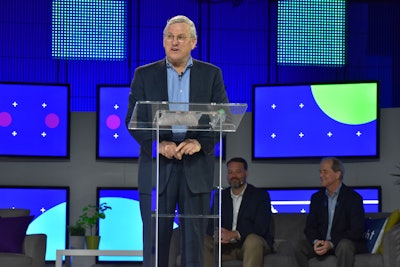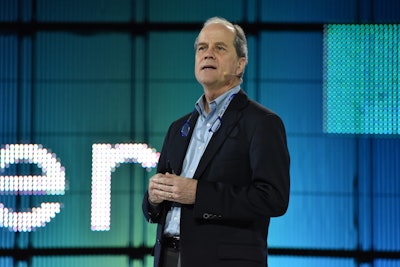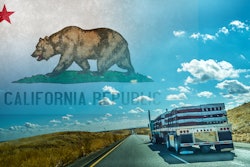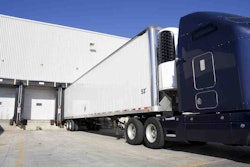 Steve Berglund, president and chief executive of Trimble, announced new executive roles for Tom Fansler and James Langley.
Steve Berglund, president and chief executive of Trimble, announced new executive roles for Tom Fansler and James Langley.“The power of together” themed the 2019 Trimble in.sight user conference in Houston on Monday, Sept. 16, with a general session at the George R. Brown Convention Center that drew more than 2,000 attendees.
A year ago, at the same location, Trimble announced the unified branding of its acquired properties PeopleNet, in 2011, and TMW Systems in 2012.
Judging by the torrent of news at this year’s event, the rebranding and reorganizing were the easy parts for Trimble Transportation. In the last year, the company has developed software on an unprecedented scale by combining resources.
“The process has been positive and constructive,” said Steve Berglund, president and chief executive of Trimble, a publicly traded company. “I’m sure there are still some identity problems for ‘what is the meaning of Trimble?’ but by and large we are beginning to demonstrate the full potential of the combination.”
For more than 20 years, Trimble has been focused on agriculture, construction, forestry and transportation industries. The company’s aspiration in these markets is “not to engage in positive impacts or change but to have transformative impacts,” Berglund explained.
The formula for success is to master each domain by understanding the users and delivering technological innovation, he said. Trimble spends more than $400 million annually on research and development, he noted.
Increasingly, Trimble is applying artificial intelligence (AI), cloud computing and data analytics to leverage big data within and across its industries. To magnify this effort, Berglund announced the appointment of Tom Fansler as chief technology and data officer of Trimble.
 Tom Fansler, chief technology and data officer of Trimble, discussed the company’s focus on creating new data products.
Tom Fansler, chief technology and data officer of Trimble, discussed the company’s focus on creating new data products.Fansler previously headed the Transportation division. Filling the vacancy is James Langley, who most recently was president of truckload carrier Dart Transit. He had previously worked at Trimble Transportation’s enterprise software division, formerly TMW, with career stops at U.S. Xpress and J.B. Hunt.
“The expectations on James are not modest,” said Berglund. In his new role as senior vice president of Trimble Transportation, Langley will have access to Fansler to “utilize the full capabilities of Trimble,” he said, as a company with annual revenues of more than $3 billion and 11,000 employees.
Trimble’s data strategy
During the in.sight conference, Langley said Trimble is uniquely positioned to help logistics companies and carriers provide solutions for shipper customers that go beyond capacity. He also said the company is focused on helping carriers achieve maximum utilization of resources by developing new data and optimization products.
Trimble customers operate more than 1.3 million combined trucks and trailers. “Utilization is where everything is going,” Langley said. “We want to double down on our data strategy. That is critically important with the things we are trying to accomplish.”
 James Langley, senior vice president of Trimble Transportation, wants to help carriers maximize utilization of resources by solving common transportation challenges with technology.
James Langley, senior vice president of Trimble Transportation, wants to help carriers maximize utilization of resources by solving common transportation challenges with technology.Tom Fansler took the stage to announce new products from Trimble that were developed this year by leveraging the company’s scale and expertise in big data and data analytics.
- Trimble Dispatch Advisor gives load planners optimized planning choices. Keith Mader, vice president of analytics, discussed how the product’s advanced mathematics account for variables like driver home time requests, hours-of-service availability, load preferences and equipment requirements. The system presents the best choices for each truck in the load and trip planning view of a carrier’s TMS system. Users can select assignment choices “with full knowledge of how they impact your plan,” he said.
- Connected Fleet Central replaces the previous web portal for the company’s fleet mobility platform to deliver a “seamless path to supporting telematics data,” Fansler said.
- Reveal with Power BI gives transportation companies using Trimble’s enterprise TMS software the “ultimate in self-serve data” to query and accessing their data “anyway you want to,” Fansler said.
- Data Trust Center gives fleet and logistics customers a secure, central hub to control what, when and how they allow third-parties to access their data. The product has simple switches that allow for integration with freight visibility providers and other connections. Through the Trust Center, Trimble’s carrier customers can know which visibility providers will receive their data and which data they’ll receive, empowering carriers to directly manage their data sharing to partners, integration by integration, down to the truck or shipper within a specific time frame.
To further address the need for data privacy, Fansler said all Trimble telematics products in North America will comply with California Senate Bill 327 that goes into effect Jan 1, 2020. California is the first state the first to pass a law of this kind that regulates the security of Internet of Things (IoT) devices that contain information about its residents.
Free visibility offering
Trimble executives stressed the unique capabilities it developed for freight visibility since acquiring 10-4 Systems in 2017 and rebranding it as Trimble Visibility.
Data integration between Trimble Visibility and its enterprise and mobility platforms give the company a unique “ecosystem” for predicting shipment arrivals using dispatch and hours-of-service data. Startup freight visibility companies “can’t match” these capabilities, said Zack Gibbs, senior product manager for Trimble Transportation. “We feel we have a competitive advantage in the marketplace.”
 Mark Botticelli, chief technology officer of Trimble Transportation, announced a new ecosystem of applications that connect with Trimble products.
Mark Botticelli, chief technology officer of Trimble Transportation, announced a new ecosystem of applications that connect with Trimble products.Trimble is now providing visibility tools to its carrier and logistics customers for free. The basic version of the visibility product will give carriers and logistics companies tools to proactively communicate shipment status with shippers via email, text and hyperlinks, Gibbs said.
The tool utilizes data pulled in from Trimble’s transportation management system (TMS) and Mobility platforms to give carriers access to real-time freight tracking information.
Trimble Transportation ecosystem
Mark Botticelli, chief technology officer of Trimble Transportation, announced the launch of the Trimble Transportation ecosystem that consolidates and unifies data access for all third-party web applications and services that its customers use.
As the Trimble ecosystem becomes larger and more diverse, “we needed a way for our technical teams to build with less hurdles,” he explained. The ecosystem fulfills that need as a hub for documentation, code samples and development testing.
The ecosystem at https://transportation.trimble.com/ also gives its customers the option to choose what data sources they want to make available for use by Trimble as de-identified data to aggregate and provide valuable market information to them in return.
If fleets and logistics providers opt in, they can supply data to Trimble’s new Market Insights product to view key industry indicators at no cost. Trimble is uniquely positioned to provide market intelligence in the transportation industry by having products for managing different parts of the supply chain, Botticelli said.
With Market Insights, users can access accurate pricing data to use for booking the right freight, he said. Other possibilities discussed at the conference for sharing data anonymously included benchmarking fleet maintenance data.
“We are providing value for whatever you opt into doing with us,” Botticelli says.
Other products announced at the in.sight conference include:
- Hosted TMS subscriptions with organized bundles that are “carefully curated with specific functionality like customer service, accounting and dispatch,” said Jon Passman, chief product and marketing officer for Trimble Transportation.
- Trimble Duo as an all-in-one vehicle gateway and Android display. Availability is expected within the next few months.
- Trimble Instinct, the next-generation mobile technology platform scheduled for a beta release by the end of the year. The new platform lets fleets utilize existing workflows and integration and select apps from Trimble and third parties.
- Risk and safety management module for the TMW Suite system that tracks details of important safety events, assigns tasks and tracks their completion.
- Fatigue monitoring as an add-on solution for the company’s Safety Analytics product. The new add-on identifies when drivers are approaching a fatigued state by using raw hours-of-service data. The product is powered by an integration with Pulsar Informatics.












